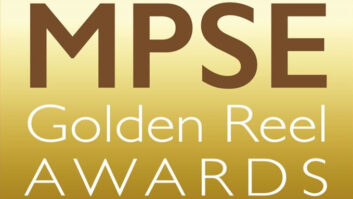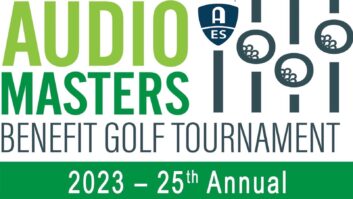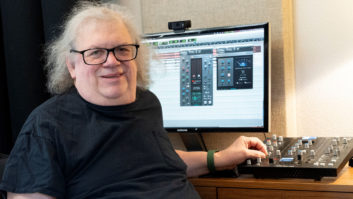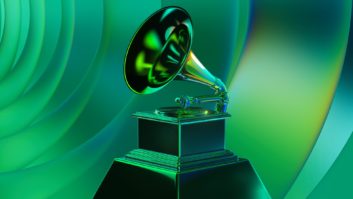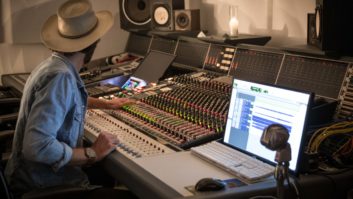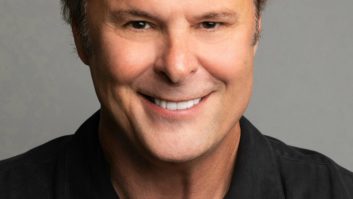Engineer Noah Passovoy at the Neve 88R inside Conway Record Studios. LOS ANGELES, CA—Obviously happy with the formula that gave rise to Overexposed, Maroon 5’s 2012 hit album, the band signed up for more of the same for V, its fifth studio full-length, which was released September 2. Swedish hit maker Max Martin is back as executive producer, the band has again embraced working with a bevy of outside writers and producers, and longtime engineer Noah Passovoy was once more behind the Neve 88R console at—again—Conway Recording Studios in Hollywood.

“This is my fourth album working with the band,” reports Passovoy, who first hooked up with Maroon 5 as the band was starting to write for its second album in 2007. The band was happy to return to Conway, he says: “It’s probably their favorite studio in town; it’s just a fantastic place to work.”
Both the band’s lead guitarist, James Valentine, and keyboard player Jesse Carmichael, back after a two-year hiatus, have project studios, says Passovoy. “They do a lot of work at home and have gotten heavily into recording over the past few years; they’ve become quite good at using the studio. In order to make music today, you have to have a little bit of all those areas to draw from.” As a result, “The demoing and recording phases are all blurred together. For them, the writing is the recording. A lot of the parts end up on the final recording, but at the same time, there’s writing in the studio.”
Tracking got underway at Conway in February 2014 after a couple of writing sessions, wrapping up in June, with a few breaks for shows. Serban Ghenea, a multi-Grammy-winner who has helped more than 100 singles and albums top the charts, mixed the new album. “He’s amazing,” says Passovoy. “As things were finished, they were sent to him to mix. For the most part, it was about focusing on a song and getting it done.” Receiving finished mixes as tracking progressed offered valuable feedback: “It started to shape the sound of the record a little bit more. There were some overdubs and fixes; he was incredibly flexible with flying those in where necessary.”
Singer Adam Levine has often favored a Shure SM7 mic in the past, but for this record, says Passovoy, “Most of the vocals were done with a [Neumann U] 67 into a Chandler TG2 preamp then an 1176, barely hitting, just getting the peaks. It’s really simple.”
Some vocals were tracked with the SM7. “Between the SM7 and the 67, those get you pretty much everything you need out of his voice. No EQ going in. It sounds like him; you don’t have to do a whole lot to it on the back end,” he says.
“With the vocals, I like to give the mixer the most room, and not over-process, but there are things that I’m willing to go to town with and print the sound that we want. Especially with guitar tones—when we hit on something we like, I’m totally willing to commit to that.”
Passovoy and Valentine like to do a fair amount of re-amping. “That way, James doesn’t have to worry so much about the tone at the time. He just gets the part down, then we listen to what it’s going to sound like and we can play around with it.”
Bass player Mickey Madden’s sound is more straightforward, he continues: “It’s a mix between a DI (Avalon U5 DI into a Neve 1081 pre, a Lang PEQ-4, and an 1176 or a Distressor, depending on the track) and a cabinet, which is usually one of Mickey’s [Ampeg] B15s. There are certainly some songs where he needed a harsher tone, so I really got into using a Distressor; I slammed that and got a really nice distortion out of it.”
He likes to put up a lot of different mics on drums. “I have an old telephone that I can use as a mono overhead. If you want a telephone sound, you might as well record through a telephone!”
The room at Conway is great for drums, he continues: “Just putting up a pair of 87s, it sounds perfect. I have a mid-room mic that gets squashed within an inch of its life. It’s right in the center of the room, so it became another piano sound, and I used it for percussion, as well.”
For the main piano sound, he says, “We used a pair of C12s, Neve pres and a 33609, then a stereo Royer further away; we’d decide between those mics. Then that crushed room mic, which occasionally found its way on for a specific sound.”
The rest of the keys went through DIs. “There were probably 12 synths in the control room. One of the techs built a switcher with 12 stereo inputs, and outputs at mic level. It has a big knob on the front and you just pick the synth. That goes to two mic pres; it’s a brilliant, simple design,” he says.
With so many platforms available to artists, the time from tracking to release feels like it’s getting shorter. “It does seem to be going that way,” Passovoy agrees. “There’s a much faster turnaround nowadays. I like it; you record it on Monday and it’s out on Friday. You’re making music for today, not in a year, so it keeps things moving.”
Conway Recording Studios
conwayrecording.com
